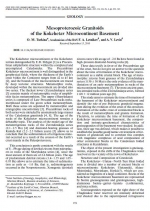Добрый день, Коллеги. Важное сообщение, просьба принять участие. Музей Ферсмана ищет помощь для реставрационных работ в помещении. Подробности по ссылке
Mesoproterozoic Granitoids of the Kokchetav Microcontinent Basement
The Kokchetav microcontinent or the Kokchetav terrain distinguished by E.D. Shlygin [1] is a Precam-brian subplatform structure within the completed and uncompleted Caledonides. The Precambrian Kokchetav microcontinent is well distinguished in the geophysical fields, where the thickness of the Earth’s crust within the Continent ranges from 42 to 45 km [2], and the bounds of the microcontinent are traced by deep tectonic structures. Metamorphic rocks, developed within the microcontinent are divided into two series. The thickest lower (Zerendinskaya) series [3] consists mainly of metamorphic rocks of amphib-olite facies metamorphism. The upper (Sharykskaya) series is composed of Late Precambrian rocks metamorphosed under the green schist metamorphism. Both these series are separated by metamorphic and stratigraphic unconformity [3]. Precambrian rocks of both series were intruded by anomalously large masses of the Caledonian granitoids [4, 8]. The age of the rocks of the Kokchetav microcontinent remains a debatable topic. The analysis of the model age of the metaterrigenous rocks of the Zerendinskaya series (2.1–2.5 Ba) [4] and diamond-bearing gneisses of Kumdy-Kul (2.2–2.3 billion years) [5] allows us to conclude that the sedimentation of terrigenous material occurred as a result of the erosion of the Earth’s crust mainly in the Paleoproterozoic.
This conclusion is partly consistent with the results of U–Pb age dating of detrital zircons from paleoplac-ers in rocks of the Sharykskaya series [4], since the most ancient of them are of 2.6 billion years. The age of predominant detrital zircons (1.4–1.35 and 1.05– 0.95 Ba) allows us to estimate the time of sedimentation as early as ~1.0 Ba; that is, sedimentogenesis occurred in the Neoproterozoic. Xenogenic (detrital) zircon cores with an age of ~2.0 Ba have been found in high-pressure diamond-bearing rocks [6].
These data testify in favor of the Precambrian age of the crust, but do not give an answer to the question about the time of formation of the Kokchetav micro-continent as a stable crustal block. The age of meta-morphic zircons from gneisses of the Zerendinskaya series (1150 ± 50 Ma) is the only evidence of the manifestation of an early metamorphism in rocks of the microcontinent basement [7]. The most ancient granites intruded rocks of the Zerendinskaya series, formed 1128 ± 12 million years ago [8].
This study aims to estimate the time of formation of the basement of the Kokchetav microcontinent and identify the role of pre-Paleozoic granitoid magma-tism during the evolution of the crust of this structure. Formation of the stable crust of continental blocks is the result of metamorphism and granite formation. Therefore, to estimate the time of formation of the Kokchetav microcontinent basement, the composition and isotopic-geochemical characteristics of gneissogranites of the basement were studied. In addition, their age was defined, which makes it possible to establish the possible geodynamic environment of formation of granitoids and to correlate this complex with magmatic complexes of acid composition of other continental blocks in the Caledonian folded structures in Kazakhstan.
The object of the present investigation is gneissog-ranites, exposed in the cliffs of the Chaglinskoe water reservoir in the vicinity of the town of Kokchetav.
Structure and Composition of Granitoids
The Kokchetav–Ulutau–North Tien Shan folded zone is divided into a number of ancient blocks or microcontinents: Kokchetav, Ulutausskii, Aktau-Mointinskii, Moyinkum, Iliyskii(?), which are considered as fragments of a large continent. Rocks of the Kokchetav microcontinent basement are represented by biotite gneissogranites and granitogneisses, high-aluminous biotite–garnet–kyanite (±sillimanite), and mica schists.




